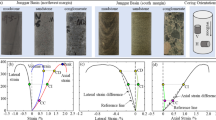Abstract
To determine the minimum crack width that can be detected using the impact-echo method, two types of laboratory experiment on concrete plate specimens were conducted. In each experiment, a crack was propagated through the plate parallel to the plate surfaces, while surface displacements caused by the crack opening were measured and impact-echo tests were performed along the crack trajectory. The relationship between the surface displacements and the real crack-opening displacements was established using the results of nonlinear fracture analyses. The minimum crack width was determined by estimating the crack-opening displacements for each impact-echo test location. As a result of this work, the minimum crack width which can be detected was found to be 0.025 mm, and the minimum crack width for which stress waves are not transmitted across the crack faces was found to be 0.08 mm. This paper describes how crack-opening displacements were determined using nonlinear fracture analyses.
Resume
On a exécuté deux types d'essais en laboratoire sur des échantillons de plaques de béton afin de déterminer quelle est la fissure minimale détectable par la méthode d'émission acoustique. Dans chaque essai, une fissure était propagée à travers la plaque parallèlement à la surface, tandis que le déplacement superficiel entraîné par l'ouverture de la fissure était mesuré et des essais d'émission acoustique réalisés le long du trajet de la fissure. En utilisant les résultats des analyses de rupture non linéaire, on a établi la relation entre le déplacement superficiel et le déplacement de la véritable ouverture causée par la fissure. On a déterminé la largeur minimale de la fissure par l'estimation des déplacements d'ouverture à chaque point par la méthode d'émission acoustique. Il résulte de cette étude que la largeur minimale de fissure détectable était de 0,025 mm et que la largeur minimale pour laquelle aucune onde de contrainte ne se propage dans les bords de la fissure était de 0,08 mm. Ici, on décrit comment, en utilisant les analyse de rupture non linéaire, on a déterminé les déplacements créés par l'ouverture de la fissure.
Similar content being viewed by others
References
Cheng, C. and Sansalone, M., ‘Determining the minimum crack width that can be detected using the impact-echo method. Part 1. Experimental study’,Mater. Struct. 28 (1995) 74–82.
Bazant, Z. P., ‘Mechanics of fracture and progressive cracking in concrete structures’, in ‘Fracture Mechanics of Concrete: Structural Application and Numerical Calculation’ (Martinus Nijhoff, Dordrecht, 1985) pp. 1–85.
Horii, H., ‘Mechanisms of fracture in brittle disordered materials’, in Fracture Processes in Concrete, Rock and Ceramics. Vol. 1 (E & FN Spon, London, 1991) pp. 95–110.
Du, Jiaji, Hawkins, N. M. and Kobayashi, A. S., ‘A hybrid analysis of fracture process zone in concrete’, in ‘Fracture of Concrete and Rock’ (Springer-Verlag, Berlin, 1989) pp. 297–306.
Hellan, K., ‘Introduction to Fracture Mechanics’, (McGraw-Hill, New York, 1984) pp. 73–107.
Kobayashi, A. S., Hawkins, N. M., and Bradt, R. C., ‘Fracture process zone in concrete and ceramics— a matter of scaling’, in ‘Toughening Mechanisms in Quasi-brittle Materials’ (Kluwer, Dordrecht, 1991).
Ingraffea, A. R. and Saouma V., ‘Numerical modeling of discrete crac propagation in reinforced and plain concrete’, in ‘Fracture Mechanics of Concrete: Structural Application and Numerical Calculation’ (Martinus Nijhoff, Dordrecht, 1985) pp. 171–122.
Bazant, Z. P. and Oh, B. H., ‘Crack band theory for fracture of concrete’,Mater. Construct. 16 (1983) 155–177.
Hiilerborg, A., Modeer, M. and Petersson, P. E., ‘Analysis of crack formation and crack growth in concrete by means of fracture mechanics and finite elements’,Cement Concr. Res. 6 (1976) 773–782.
Carpinteri, A., ‘Interpretation of the Griffith instability as a bifurcation on the global equilibriu’, in ‘Application of Fracture Mechanics to Cementitious Composites’, NATO-ARW, 1984, pp. 287–316.
Jenq, Y. S. and Shah, S. P., ‘Two parameter fracture model for concrete’,J. Engng Mech. ASCE,111 (1985) 1227–1241.
Petersson, P. E., ‘Crack growth and development of fracture zones in plain concrete and similar materials’, Division of Building Materials, University of Lund, Sweden, 1981, Report TVBM-1006.
Bittencourt, T. N., ‘Computer simulation of linear and nonlinear crack propagation in cementitious materials’, Ph.D Thesis, Civil & Environmental Engineering, Cornell University, NY, 1993.
Sansalone, M. and Carino, N. J., ‘Impact-Echo: A Method for Flaw Detection in Concrete Using Transient Stress Waves’, NBSIR 86-3452, National Bureau of Standards, Washington, DC/PB 87-10444/AS (National Technical Information Service, Springfield, MA, September 1986).
Miller, R. A., Shah, S. P. and Bjelkhagen, H. I., ‘Crack profiles in mortar measured by holographic interferometry’,Exp. Mech. (1988) 388–394.
Wawrzynek, P. A., ‘Interactive finite element analysis of fracture processes: an integrated approach’,Theoret. Appl. Fracture Mech. 8 (1987) 137–150.
Author information
Authors and Affiliations
Rights and permissions
About this article
Cite this article
Cheng, CC., Sansalone, M. Determining the minimum crack width that can be detected using the impact-echo method Part 2. Numerical fracture analyses. Materials and Structures 28, 125–132 (1995). https://doi.org/10.1007/BF02473219
Issue Date:
DOI: https://doi.org/10.1007/BF02473219




